change time TOYOTA C-HR 2020 Warranties & Maintenance Guides (in English)
[x] Cancel search | Manufacturer: TOYOTA, Model Year: 2020, Model line: C-HR, Model: TOYOTA C-HR 2020Pages: 260, PDF Size: 8.54 MB
Page 22 of 260
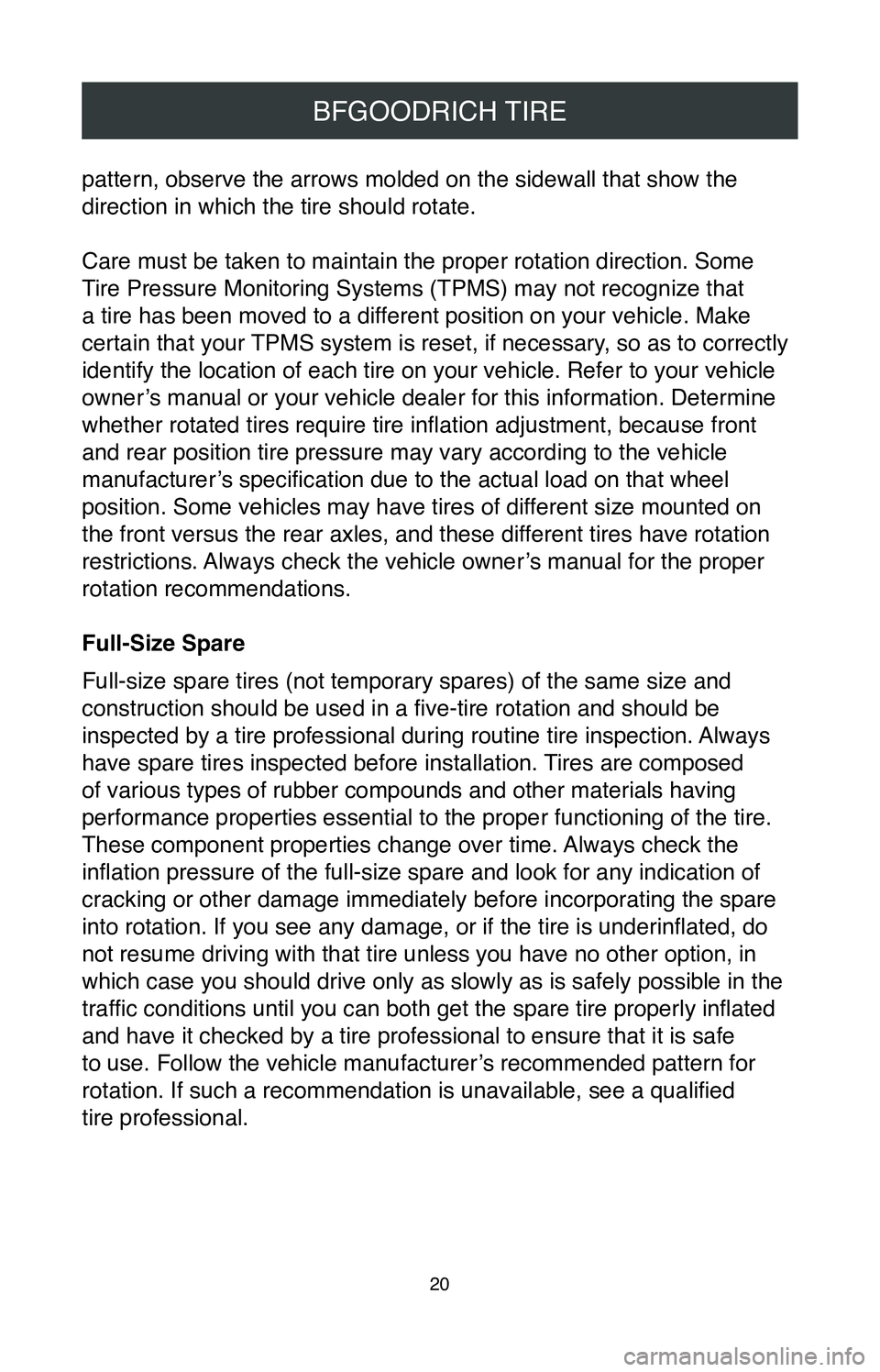
20
BFGOODRICH TIRE
pattern, observe the arrows molded on the sidewall that show the
direction in which the tire should rotate.
Care must be taken to maintain the proper rotation direction. Some
Tire Pressure Monitoring Systems (TPMS) may not recognize that
a tire has been moved to a different position on your vehicle. Make
certain that your TPMS system is reset, if necessary, so as to correctly
identify the location of each tire on your vehicle. Refer to your vehicl\
e
owner’s manual or your vehicle dealer for this information. Determine
whether rotated tires require tire inflation adjustment, because front
and rear position tire pressure may vary according to the vehicle
manufacturer’s specification due to the actual load on that wheel
position. Some vehicles may have tires of different size mounted on
the front versus the rear axles, and these different tires have rotation
restrictions. Always check the vehicle owner’s manual for the proper
rotation recommendations.
Full-Size Spare
Full-size spare tires (not temporary spares) of the same size and
construction should be used in a five-tire rotation and should be
inspected by a tire professional during routine tire inspection. Always
have spare tires inspected before installation. Tires are composed
of various types of rubber compounds and other materials having
performance properties essential to the proper functioning of the tire. \
These component properties change over time. Always check the
inflation pressure of the full-size spare and look for any indication of
cracking or other damage immediately before incorporating the spare
into rotation. If you see any damage, or if the tire is underinflated, do
not resume driving with that tire unless you have no other option, in
which case you should drive only as slowly as is safely possible in the \
traffic conditions until you can both get the spare tire properly inflated
and have it checked by a tire professional to ensure that it is safe
to use. Follow the vehicle manufacturer’s recommended pattern for
rotation. If such a recommendation is unavailable, see a qualified
tire professional.
Page 23 of 260
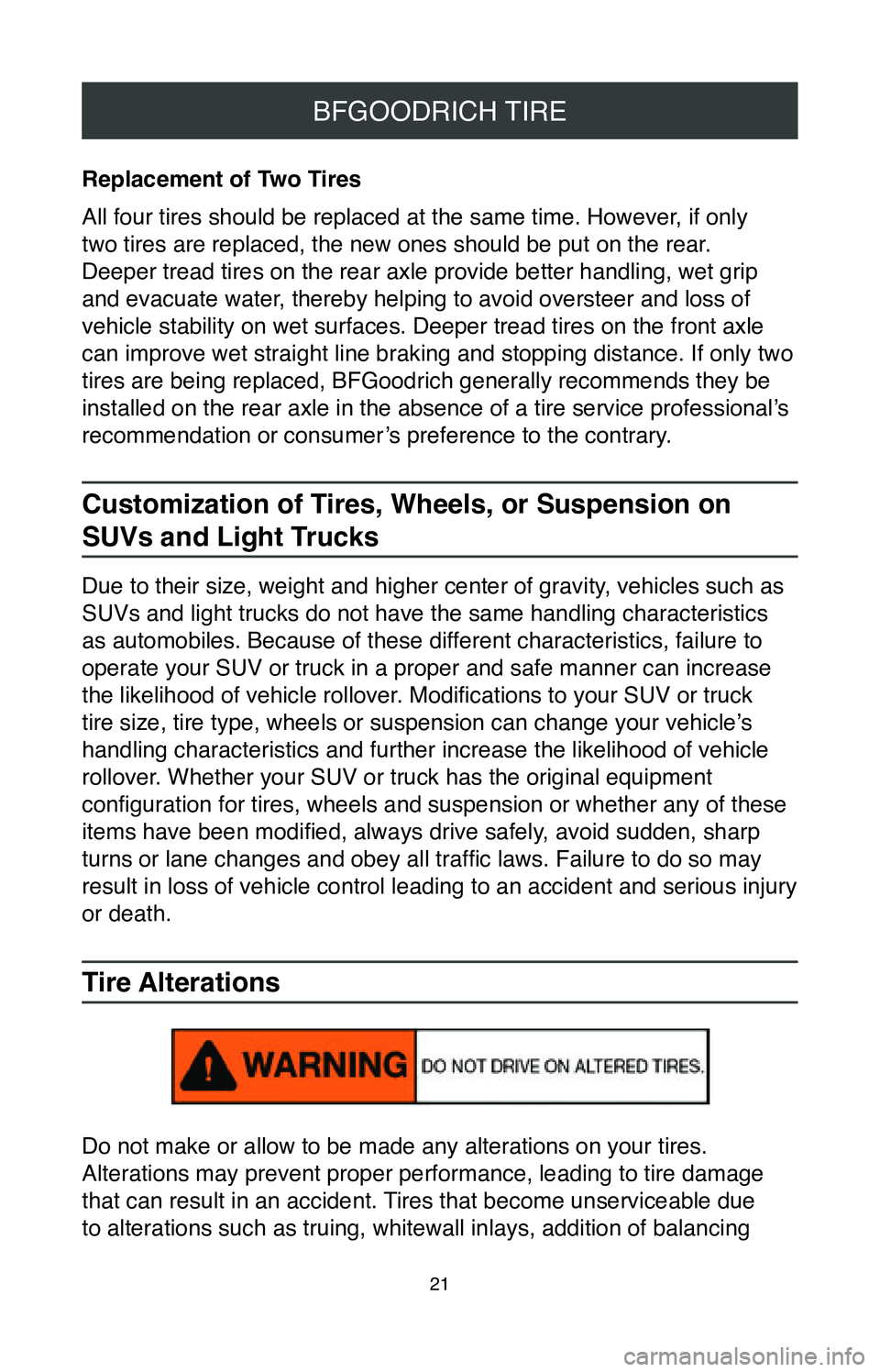
21
BFGOODRICH TIRE
Replacement of Two Tires
All four tires should be replaced at the same time. However, if only
two tires are replaced, the new ones should be put on the rear.
Deeper tread tires on the rear axle provide better handling, wet grip
and evacuate water, thereby helping to avoid oversteer and loss of
vehicle stability on wet surfaces. Deeper tread tires on the front axle \
can improve wet straight line braking and stopping distance. If only two\
tires are being replaced, BFGoodrich generally recommends they be
installed on the rear axle in the absence of a tire service professional’s
recommendation or consumer’s preference to the contrary.
Customization of Tires, Wheels, or Suspension on
SUVs and Light Trucks
Due to their size, weight and higher center of gravity, vehicles such as
SUVs and light trucks do not have the same handling characteristics
as automobiles. Because of these different characteristics, failure to
operate your SUV or truck in a proper and safe manner can increase
the likelihood of vehicle rollover. Modifications to your SUV or truck
tire size, tire type, wheels or suspension can change your vehicle’ s
handling characteristics and further increase the likelihood of vehicle \
rollover. Whether your SUV or truck has the original equipment
configuration for tires, wheels and suspension or whether any of these
items have been modified, always drive safely, avoid sudden, sharp
turns or lane changes and obey all traffic laws. Failure to do so may
result in loss of vehicle control leading to an accident and serious injury
or death.
Tire Alterations
Do not make or allow to be made any alterations on your tires.
Alterations may prevent proper performance, leading to tire damage
that can result in an accident. Tires that become unserviceable due
to alterations such as truing, whitewall inlays, addition of balancing
Page 25 of 260
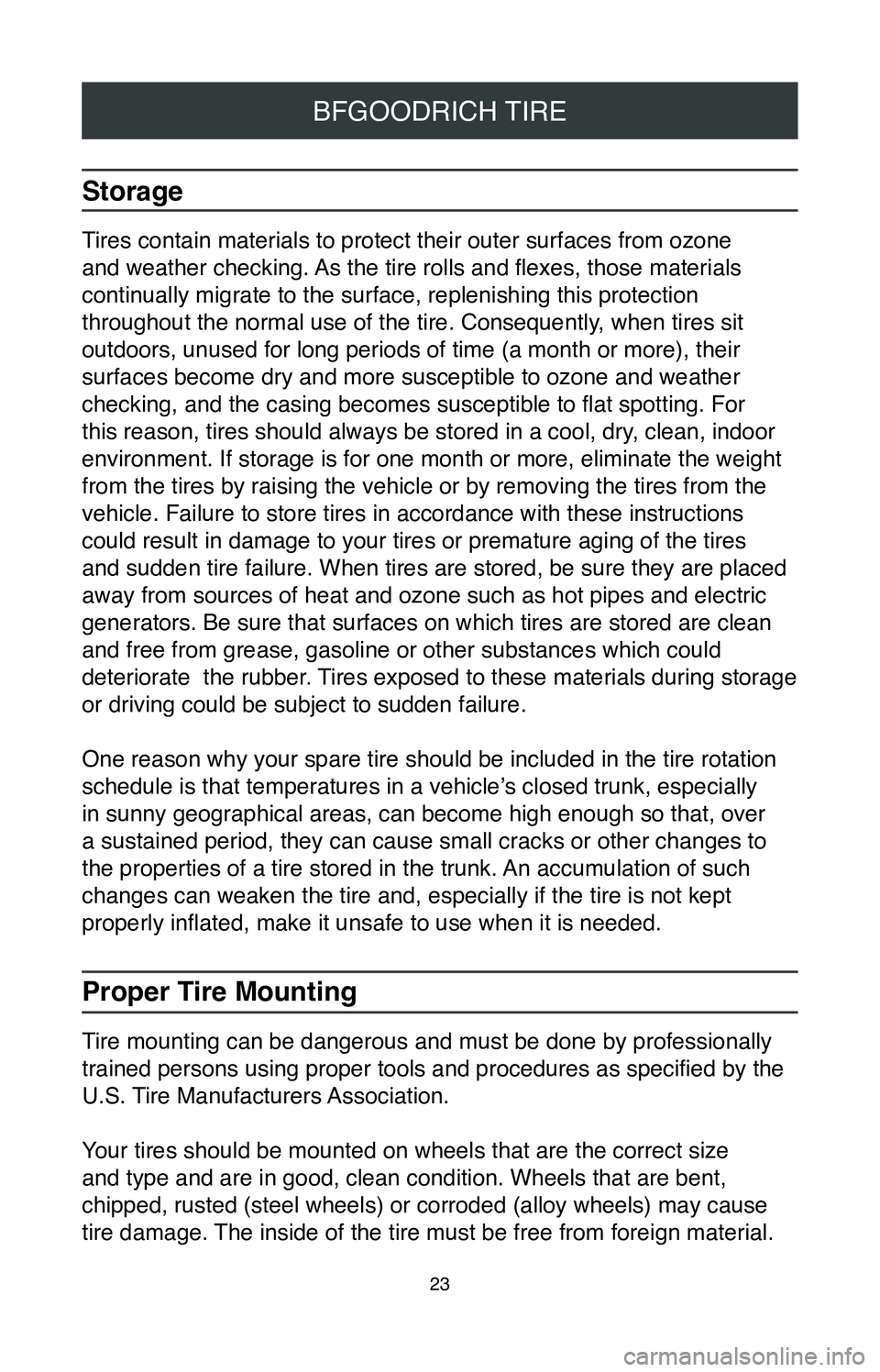
23
BFGOODRICH TIRE
Storage
Tires contain materials to protect their outer surfaces from ozone
and weather checking. As the tire rolls and flexes, those materials
continually migrate to the surface, replenishing this protection
throughout the normal use of the tire. Consequently, when tires sit
outdoors, unused for long periods of time (a month or more), their
surfaces become dry and more susceptible to ozone and weather
checking, and the casing becomes susceptible to flat spotting. For
this reason, tires should always be stored in a cool, dry, clean, indoor
environment. If storage is for one month or more, eliminate the weight
from the tires by raising the vehicle or by removing the tires from the \
vehicle. Failure to store tires in accordance with these instructions
could result in damage to your tires or premature aging of the tires
and sudden tire failure. When tires are stored, be sure they are placed \
away from sources of heat and ozone such as hot pipes and electric
generators. Be sure that surfaces on which tires are stored are clean
and free from grease, gasoline or other substances which could
deteriorate the rubber. Tires exposed to these materials during storage
or driving could be subject to sudden failure.
One reason why your spare tire should be included in the tire rotation
schedule is that temperatures in a vehicle’s closed trunk, especially
in sunny geographical areas, can become high enough so that, over
a sustained period, they can cause small cracks or other changes to
the properties of a tire stored in the trunk. An accumulation of such
changes can weaken the tire and, especially if the tire is not kept
properly inflated, make it unsafe to use when it is needed.
Proper Tire Mounting
Tire mounting can be dangerous and must be done by professionally
trained persons using proper tools and procedures as specified by the
U.S. Tire Manufacturers Association.
Your tires should be mounted on wheels that are the correct size
and type and are in good, clean condition. Wheels that are bent,
chipped, rusted (steel wheels) or corroded (alloy wheels) may cause
tire damage. The inside of the tire must be free from foreign material.
Page 27 of 260
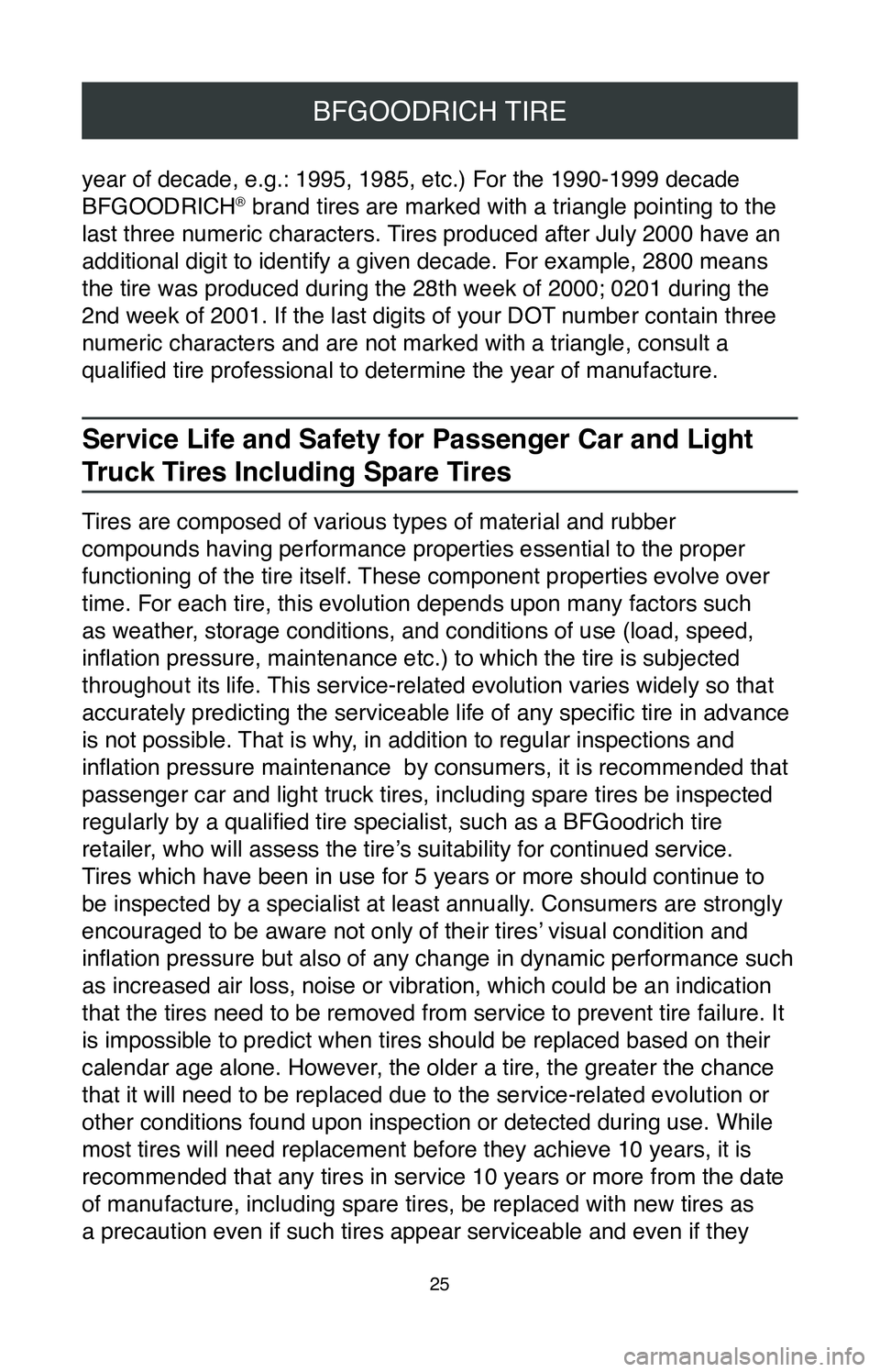
25
BFGOODRICH TIRE
year of decade, e.g.: 1995, 1985, etc.) For the 1990-1999 decade
BFGOODRICH® brand tires are marked with a triangle pointing to the
last three numeric characters. Tires produced after July 2000 have an
additional digit to identify a given decade. For example, 2800 means
the tire was produced during the 28th week of 2000; 0201 during the
2nd week of 2001. If the last digits of your DOT number contain three
numeric characters and are not marked with a triangle, consult a
qualified tire professional to determine the year of manufacture.
Service Life and Safety for Passenger Car and Light
Truck Tires Including Spare Tires
Tires are composed of various types of material and rubber
compounds having performance properties essential to the proper
functioning of the tire itself. These component properties evolve over
time. For each tire, this evolution depends upon many factors such
as weather, storage conditions, and conditions of use (load, speed,
inflation pressure, maintenance etc.) to which the tire is subjected
throughout its life. This service-related evolution varies widely so that
accurately predicting the serviceable life of any specific tire in advance
is not possible. That is why, in addition to regular inspections and
inflation pressure maintenance by consumers, it is recommended that
passenger car and light truck tires, including spare tires be inspected \
regularly by a qualified tire specialist, such as a BFGoodrich tire
retailer, who will assess the tire’s suitability for continued service.
Tires which have been in use for 5 years or more should continue to
be inspected by a specialist at least annually. Consumers are strongly
encouraged to be aware not only of their tires’ visual condition and
inflation pressure but also of any change in dynamic performance such
as increased air loss, noise or vibration, which could be an indication \
that the tires need to be removed from service to prevent tire failure. \
It
is impossible to predict when tires should be replaced based on their
calendar age alone. However, the older a tire, the greater the chance
that it will need to be replaced due to the service-related evolution or
other conditions found upon inspection or detected during use. While
most tires will need replacement before they achieve 10 years, it is
recommended that any tires in service 10 years or more from the date
of manufacture, including spare tires, be replaced with new tires as
a precaution even if such tires appear serviceable and even if they
Page 39 of 260
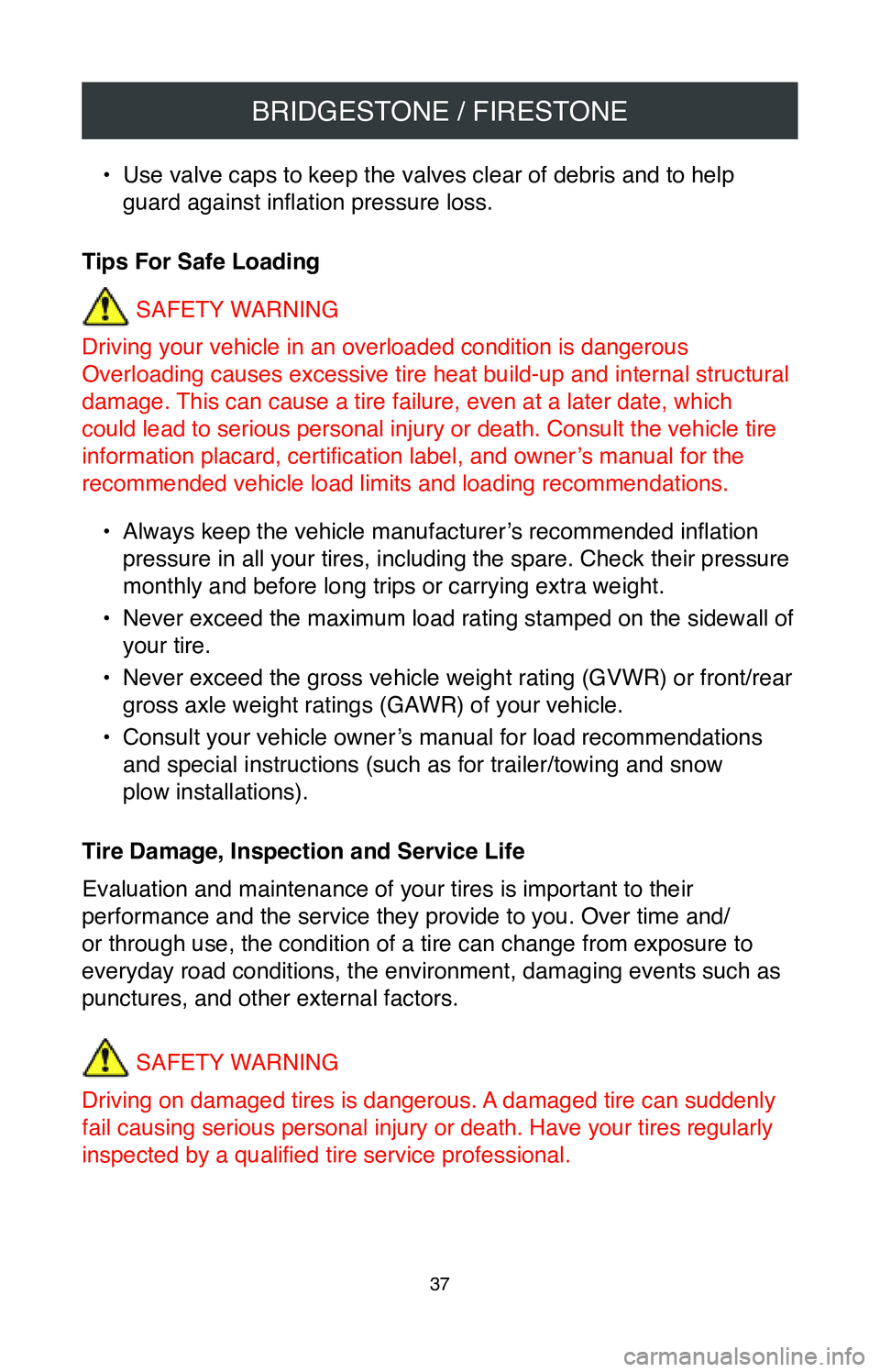
BRIDGESTONE / FIRESTONE
37
• Use valve caps to keep the valves clear of debris and to help
guard against inflation pressure loss.
Tips For Safe Loading SAFETY WARNING
Driving your vehicle in an overloaded condition is dangerous
Overloading causes excessive tire heat build-up and internal structural
damage. This can cause a tire failure, even at a later date, which
could lead to serious personal injury or death. Consult the vehicle tire
information placard, certification label, and owner’s manual for the
recommended vehicle load limits and loading recommendations.
•
Always keep the vehicle manufacturer’s recommended inflation
pressure in all your tires, including the spare. Check their pressure
monthly and before long trips or carrying extra weight.
•
Never exceed the maximum load rating stamped on the sidewall of
your tire.
•
Never exceed the gross vehicle weight rating (GVWR) or front/rear
gross axle weight ratings (GAWR) of your vehicle.
•
Consult your vehicle owner’s manual for load recommendations
and special instructions (such as for trailer/towing and snow
plow installations).
Tire Damage, Inspection and Service Life
Evaluation and maintenance of your tires is important to their
performance and the service they provide to you. Over time and/
or through use, the condition of a tire can change from exposure to
everyday road conditions, the environment, damaging events such as
punctures, and other external factors.
SAFETY WARNING
Driving on damaged tires is dangerous. A damaged tire can suddenly
fail causing serious
personal injury or death. Have your tires regularly
inspected by a qualified tire service professional.
Page 93 of 260
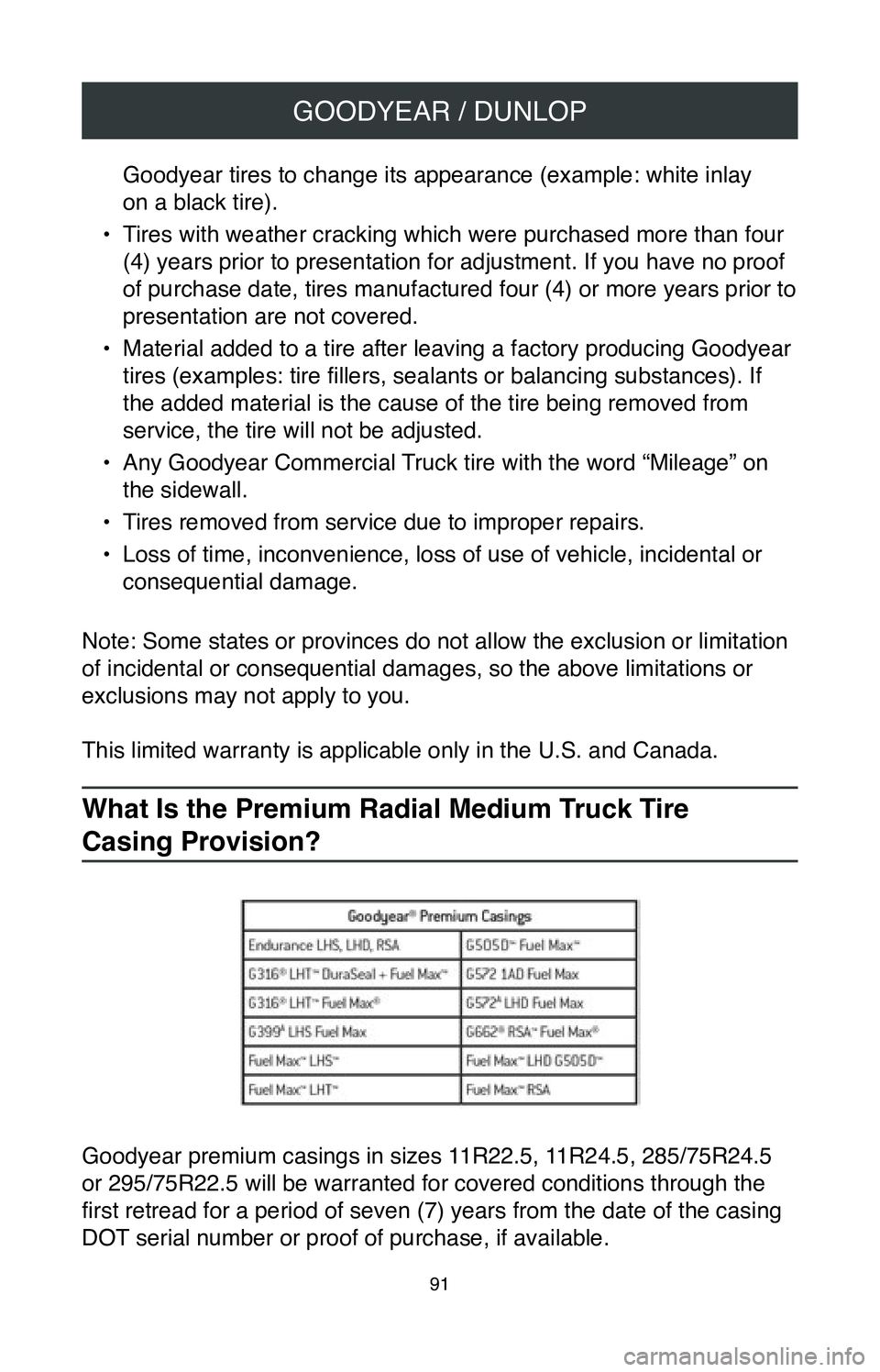
GOODYEAR / DUNLOP
91
Goodyear tires to change its appearance (example: white inlay
on a black tire).
•
Tires with weather cracking which were purchased more than four
(4) years prior to presentation for adjustment. If you have no proof
of purchase date, tires manufactured four (4) or more years prior to
presentation are not covered.
•
Material added to a tire after leaving a factory producing Goodyear
tires (examples: tire fillers, sealants or balancing substances). If
the added material is the cause of the tire being removed from
service, the tire will not be adjusted.
•
Any Goodyear Commercial Truck tire with the word “Mileage” on
the sidewall.
•
Tires removed from service due to improper repairs.
•
Loss of time, inconvenience, loss of use of vehicle, incidental or
consequential damage.
Note: Some states or provinces do not allow the exclusion or limitation \
of incidental or consequential damages, so the above limitations or
exclusions may not apply to you.
This limited warranty is applicable only in the U.S. and Canada.
What Is the Premium Radial Medium Truck Tire
Casing Provision?
Goodyear premium casings in sizes 11R22.5, 11R24.5, 285/75R24.5
or 295/75R22.5 will be warranted for covered conditions through the
first retread for a period of seven (7) years from the date of the casing
DOT serial number or proof of purchase, if available.
Page 139 of 260
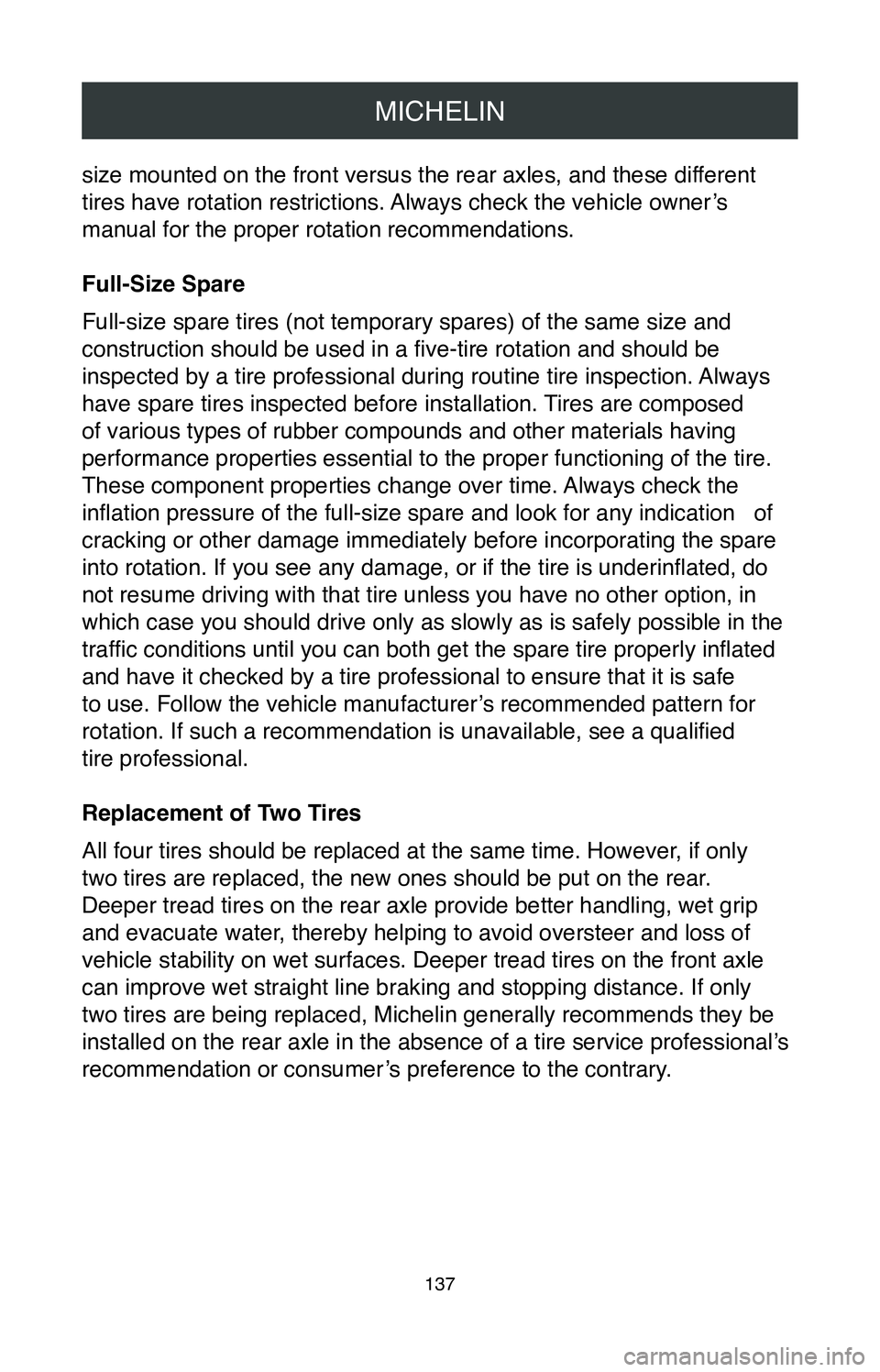
MICHELIN
137
size mounted on the front versus the rear axles, and these different
tires have rotation restrictions. Always check the vehicle owner’s
manual for the proper rotation recommendations.
Full-Size Spare
Full-size spare tires (not temporary spares) of the same size and
construction should be used in a five-tire rotation and should be
inspected by a tire professional during routine tire inspection. Always
have spare tires inspected before installation. Tires are composed
of various types of rubber compounds and other materials having
performance properties essential to the proper functioning of the tire. \
These component properties change over time. Always check the
inflation pressure of the full-size spare and look for any indication of
cracking or other damage immediately before incorporating the spare
into rotation. If you see any damage, or if the tire is underinflated, do
not resume driving with that tire unless you have no other option, in
which case you should drive only as slowly as is safely possible in the \
traffic conditions until you can both get the spare tire properly inflated
and have it checked by a tire professional to ensure that it is safe
to use. Follow the vehicle manufacturer’s recommended pattern for
rotation. If such a recommendation is unavailable, see a qualified
tire professional.
Replacement of Two Tires
All four tires should be replaced at the same time. However, if only
two tires are replaced, the new ones should be put on the rear.
Deeper tread tires on the rear axle provide better handling, wet grip
and evacuate water, thereby helping to avoid oversteer and loss of
vehicle stability on wet surfaces. Deeper tread tires on the front axle \
can improve wet straight line braking and stopping distance. If only
two tires are being replaced, Michelin generally recommends they be
installed on the rear axle in the absence of a tire service professional’ s
recommendation or consumer’s preference to the contrary.
Page 152 of 260
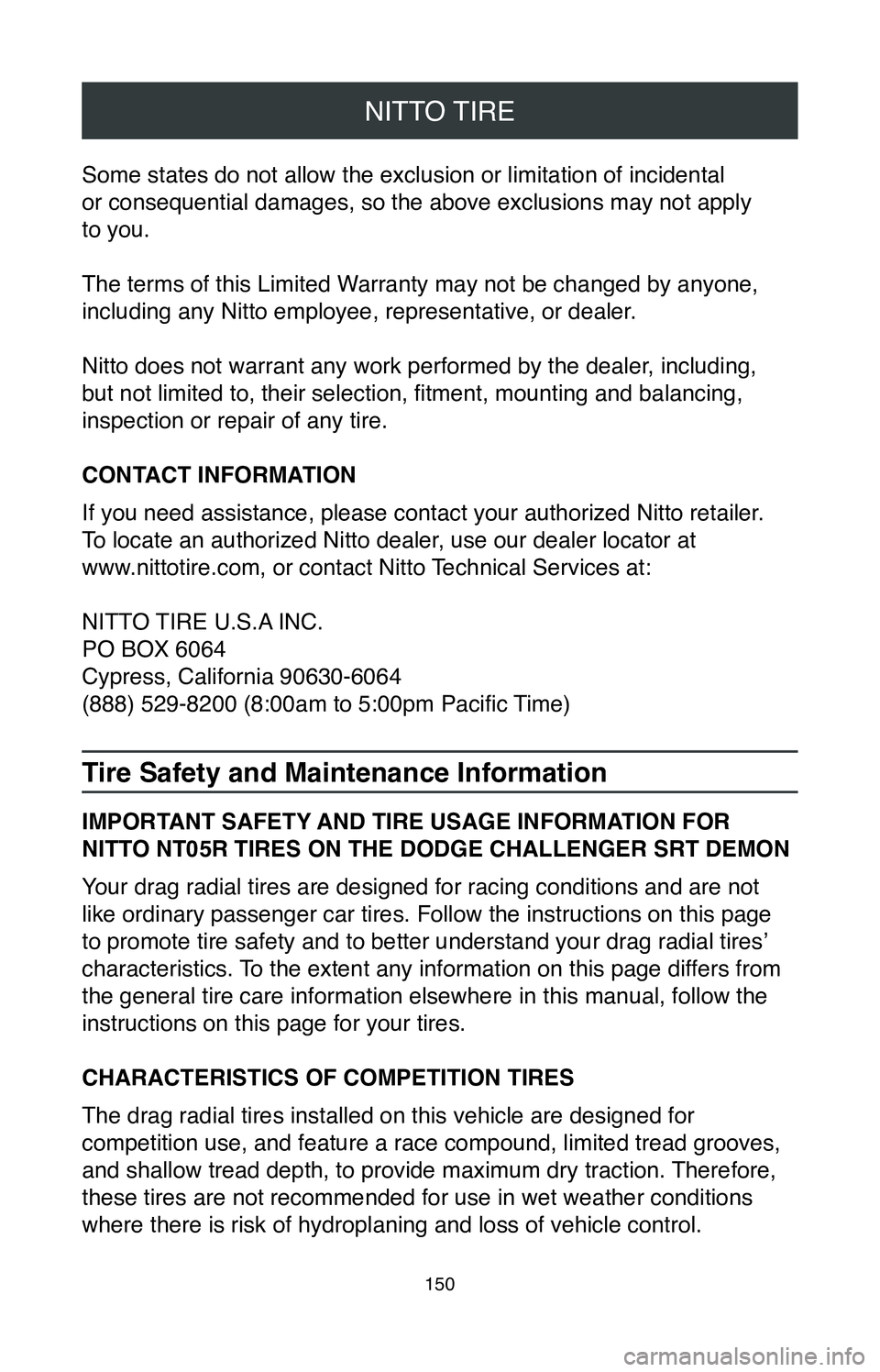
NITTO TIRE
150
Some states do not allow the exclusion or limitation of incidental
or consequential damages, so the above exclusions may not apply
to you.
The terms of this Limited Warranty may not be changed by anyone,
including any Nitto employee, representative, or dealer.
Nitto does not warrant any work performed by the dealer, including,
but not limited to, their selection, fitment, mounting and balancing,
inspection or repair of any tire.
CONTACT INFORMATION
If you need assistance, please contact your authorized Nitto retailer.
To locate an authorized Nitto dealer, use our dealer locator at
www.nittotire.com, or contact Nitto Technical Services at:
NITTO TIRE U.S.A INC.
PO BOX 6064
Cypress, California 90630-6064
(888) 529-8200 (8:00am to 5:00pm Pacific Time)
Tire Safety and Maintenance Information
IMPORTANT SAFETY AND TIRE USAGE INFORMATION FOR
NITTO NT05R TIRES ON THE DODGE CHALLENGER SRT DEMON
Your drag radial tires are designed for racing conditions and are not
like ordinary passenger car tires. Follow the instructions on this page \
to promote tire safety and to better understand your drag radial tires’
characteristics. To the extent any information on this page differs from
the general tire care information elsewhere in this manual, follow the
instructions on this page for your tires.
CHARACTERISTICS OF COMPETITION TIRES
The drag radial tires installed on this vehicle are designed for
competition use, and feature a race compound, limited tread grooves,
and shallow tread depth, to provide maximum dry traction. Therefore,
these tires are not recommended for use in wet weather conditions
where there is risk of hydroplaning and loss of vehicle control.
Page 205 of 260
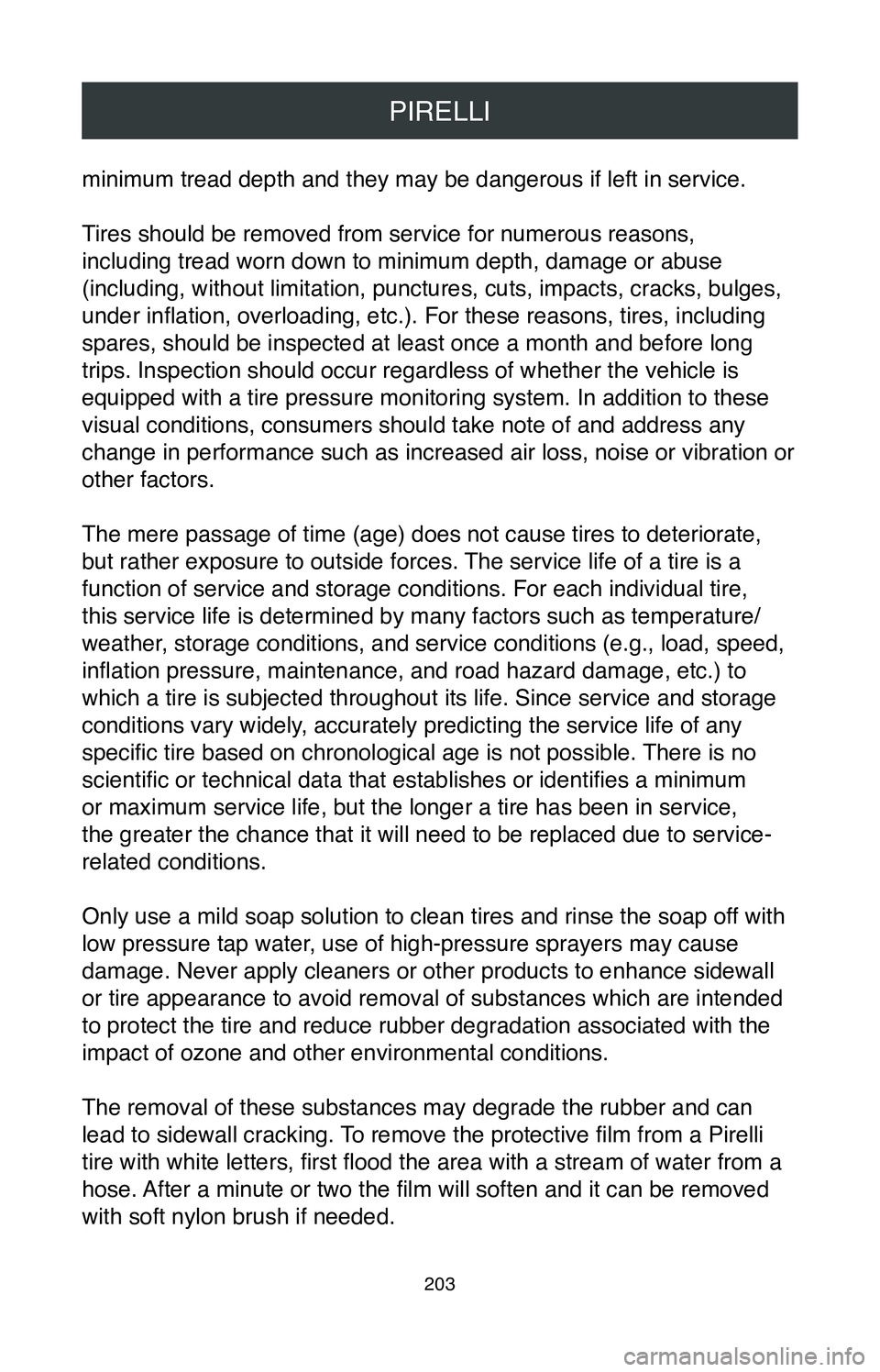
PIRELLI
203
minimum tread depth and they may be dangerous if left in service.
Tires should be removed from service for numerous reasons,
including tread worn down to minimum depth, damage or abuse
(including, without limitation, punctures, cuts, impacts, cracks, bulges,
under inflation, overloading, etc.). For these reasons, tires, including
spares, should be inspected at least once a month and before long
trips. Inspection should occur regardless of whether the vehicle is
equipped with a tire pressure monitoring system. In addition to these
visual conditions, consumers should take note of and address any
change in performance such as increased air loss, noise or vibration or \
other factors.
The mere passage of time (age) does not cause tires to deteriorate,
but rather exposure to outside forces. The service life of a tire is a
function of service and storage conditions. For each individual tire,
this service life is determined by many factors such as temperature/
weather, storage conditions, and service conditions (e.g., load, speed,
inflation pressure, maintenance, and road hazard damage, etc.) to
which a tire is subjected throughout its life. Since service and storage
conditions vary widely, accurately predicting the service life of any
specific tire based on chronological age is not possible. There is no
scientific or technical data that establishes or identifies a minimum
or maximum service life, but the longer a tire has been in service,
the greater the chance that it will need to be replaced due to service-
related conditions.
Only use a mild soap solution to clean tires and rinse the soap off with
low pressure tap water, use of high-pressure sprayers may cause
damage. Never apply cleaners or other products to enhance sidewall
or tire appearance to avoid removal of substances which are intended
to protect the tire and reduce rubber degradation associated with the
impact of ozone and other environmental conditions.
The removal of these substances may degrade the rubber and can
lead to sidewall cracking. To remove the protective film from a Pirelli
tire with white letters, first flood the area with a stream of water from a
hose. After a minute or two the film will soften and it can be removed
with soft nylon brush if needed.
Page 213 of 260
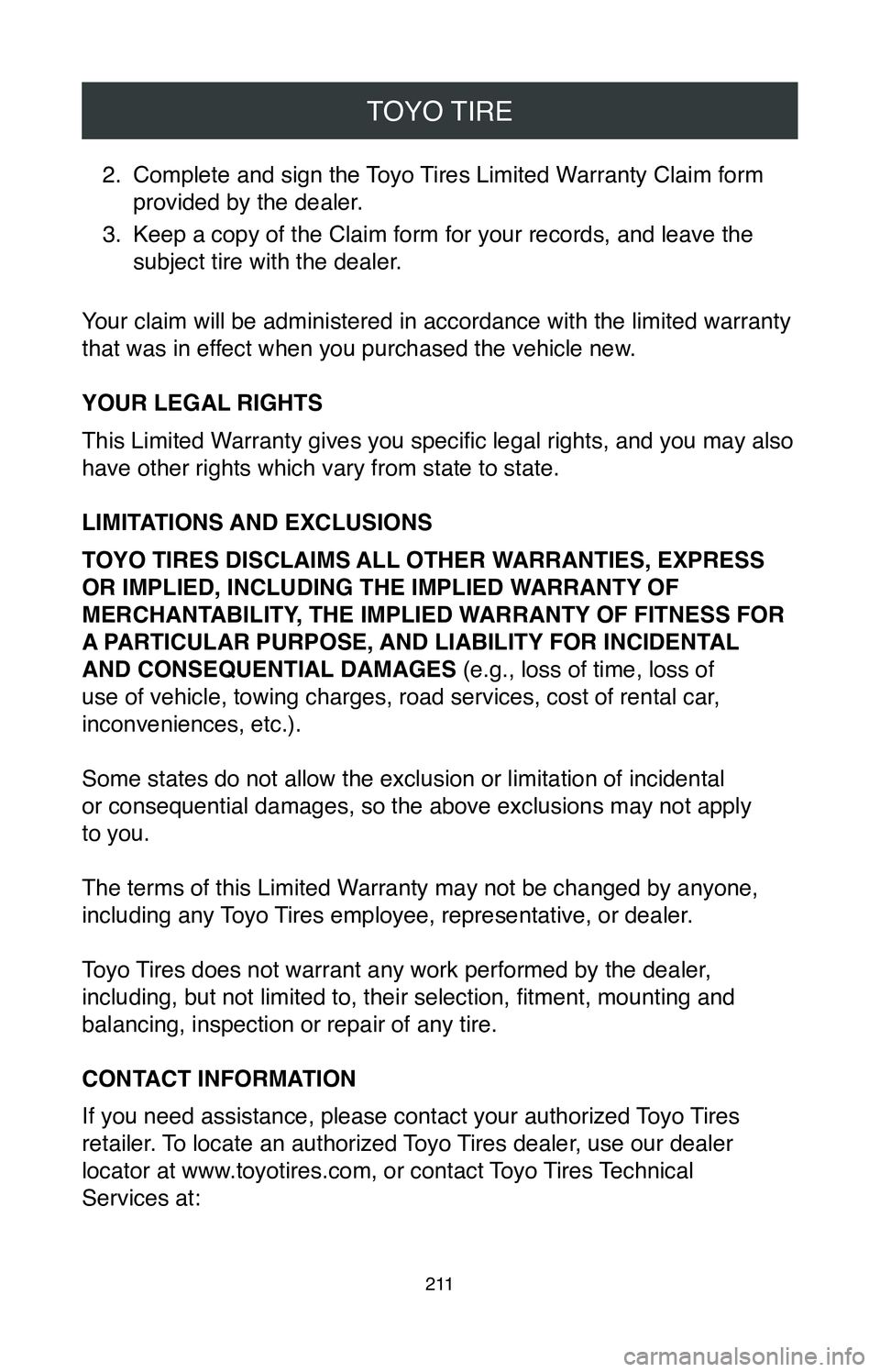
TOYO TIRE
2 11
2. Complete and sign the Toyo Tires Limited Warranty Claim form
provided by the dealer.
3.
Keep a copy of the Claim form for your records, and leave the
subject tire with the dealer.
Your claim will be administered in accordance with the limited warranty
that was in effect when you purchased the vehicle new.
YOUR LEGAL RIGHTS
This Limited Warranty gives you specific legal rights, and you may also
have other rights which vary from state to state.
LIMITATIONS AND EXCLUSIONS
TOYO TIRES DISCLAIMS ALL OTHER WARRANTIES, EXPRESS
OR IMPLIED, INCLUDING THE IMPLIED WARRANTY OF
MERCHANTABILITY, THE IMPLIED WARRANTY OF FITNESS FOR
A PARTICULAR PURPOSE, AND LIABILITY FOR INCIDENTAL
AND CONSEQUENTIAL DAMAGES (e.g., loss of time, loss of
use of vehicle, towing charges, road services, cost of rental car,
inconveniences, etc.).
Some states do not allow the exclusion or limitation of incidental
or consequential damages, so the above exclusions may not apply
to you.
The terms of this Limited Warranty may not be changed by anyone,
including any Toyo Tires employee, representative, or dealer.
Toyo Tires does not warrant any work performed by the dealer,
including, but not limited to, their selection, fitment, mounting and
balancing, inspection or repair of any tire.
CONTACT INFORMATION
If you need assistance, please contact your authorized Toyo Tires
retailer. To locate an authorized Toyo Tires dealer, use our dealer
locator at www.toyotires.com, or contact Toyo Tires Technical
Services at: